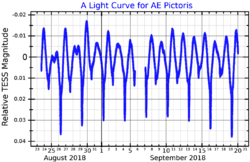Astronomy:AE Pictoris
| Observation data Equinox J2000.0]] (ICRS) | |
|---|---|
| Constellation | Pictor |
| Right ascension | 06h 31m 10.63900s[2] |
| Declination | −61° 52′ 46.3515″[2] |
| Apparent magnitude (V) | 6.14[3] |
| Characteristics | |
| Spectral type | B3V[4] |
| B−V color index | −0.147±0.006[5] |
| Variable type | Eclipsing binary[6] |
| Astrometry | |
| Radial velocity (Rv) | 34.0±7.4[5] km/s |
| Proper motion (μ) | RA: −9.142[2] mas/yr Dec.: +12.087[2] mas/yr |
| Parallax (π) | 2.2770 ± 0.0678[2] mas |
| Distance | 1,430 ± 40 ly (440 ± 10 pc) |
| Absolute magnitude (MV) | 1.73[5] |
| Orbit[7] | |
| Period (P) | 2.9723 d |
| Eccentricity (e) | 0.10 |
| Periastron epoch (T) | 2,431,998.871 JD |
| Argument of periastron (ω) (secondary) | 39.0° |
| Semi-amplitude (K1) (primary) | 119.0 km/s |
| Details | |
| Mass | 7.1±0.1[8] M☉ |
| Luminosity (bolometric) | 2,569[9] L☉ |
| Temperature | 18,700[9] K |
| Rotation | 1.490911 d[10] |
| Age | 27.7±1.4[8] Myr |
| Other designations | |
| Database references | |
| SIMBAD | data |
AE Pictoris is an eclipsing binary[6] star system in the southern constellation of Pictor. This dim, blue-white hued point of light is just barely visible to the naked eye; it has an apparent visual magnitude of 6.09, which drops to magnitude 6.14 during an eclipse.[12] The system is located around 1,430 light years away from the Sun based on parallax,[2] and it is receding with a radial velocity of 34 km/s.[13]
This is a single-lined spectroscopic binary system with an orbital period of 2.97 days and an eccentricity of 0.10. The minimum value of the semimajor axis for the pair is 4.8 Gm (6.9 R☉).[7] It is classed as a probable eclipsing binary variable (EB:), but with some uncertainty regarding the specific type.[6] This is a candidate runaway star system, having a peculiar velocity of 24.9+4.9
−5.1 km/s relative to its neighbors.[8] The visible component is a B-type main-sequence star with a stellar classification of B3V.[4] it is 28 million years old with seven[8] times the mass of the Sun. The star is radiating 2,569 times the luminosity of the Sun from its photosphere at an effective temperature of 18,700 K.[9]
References
- ↑ Pedersen, May G.; Chowdhury, Sowgata; Johnston, Cole; Bowman, Dominic M.; Aerts, Conny; Handler, Gerald; De Cat, Peter; Neiner, Coralie et al. (February 2019). "Diverse Variability of O and B Stars Revealed from 2-minute Cadence Light Curves in Sectors 1 and 2 of the TESS Mission: Selection of an Asteroseismic Sample". The Astrophysical Journal Letters 872 (1): L9. doi:10.3847/2041-8213/ab01e1. Bibcode: 2019ApJ...872L...9P.
- ↑ 2.0 2.1 2.2 2.3 2.4 2.5 Brown, A. G. A. (August 2018). "Gaia Data Release 2: Summary of the contents and survey properties". Astronomy & Astrophysics 616: A1. doi:10.1051/0004-6361/201833051. Bibcode: 2018A&A...616A...1G. Gaia DR2 record for this source at VizieR.
- ↑ Høg, E.; Fabricius, C.; Makarov, V. V.; Urban, S.; Corbin, T.; Wycoff, G.; Bastian, U.; Schwekendiek, P. et al. (2000), "The Tycho-2 catalogue of the 2.5 million brightest stars", Astronomy and Astrophysics 355: L27, Bibcode: 2000A&A...355L..27H.
- ↑ 4.0 4.1 Hiltner, W. A. et al. (July 1969), "MK Spectral Types for Bright Southern OB Stars", Astrophysical Journal 157: 313–326, doi:10.1086/150069, Bibcode: 1969ApJ...157..313H.
- ↑ 5.0 5.1 5.2 Anderson, E.; Francis, Ch. (2012), "XHIP: An extended hipparcos compilation", Astronomy Letters 38 (5): 331, doi:10.1134/S1063773712050015, Bibcode: 2012AstL...38..331A.
- ↑ 6.0 6.1 6.2 Samus, N. N. et al. (2017), "General Catalogue of Variable Stars", Astronomy Reports, 5.1 61 (1): 80–88, doi:10.1134/S1063772917010085, Bibcode: 2017ARep...61...80S.
- ↑ 7.0 7.1 Sahade, J.; Landi Dessy, J. (January 1950), "The Spectroscopic Binary CPD -61°669", Astrophysical Journal 111: 191, doi:10.1086/145251, Bibcode: 1950ApJ...111..191S.
- ↑ 8.0 8.1 8.2 8.3 Tetzlaff, N. et al. (January 2011), "A catalogue of young runaway Hipparcos stars within 3 kpc from the Sun", Monthly Notices of the Royal Astronomical Society 410 (1): 190–200, doi:10.1111/j.1365-2966.2010.17434.x, Bibcode: 2011MNRAS.410..190T.
- ↑ 9.0 9.1 9.2 Hohle, M. M. et al. (2010), "Masses and luminosities of O- and B-type stars and red supergiants", Astronomische Nachrichten 331 (4): 349, doi:10.1002/asna.200911355, Bibcode: 2010AN....331..349H.
- ↑ Barraza, L. F.; Gomes, R. L.; Messias, Y. S.; Leão, I. C.; Almeida, L. A.; Janot-Pacheco, E.; Brito, A. C.; Brito, F. A. C. et al. (2022). "Rotation Signature of TESS B-type Stars. A Comprehensive Analysis". The Astrophysical Journal 924 (2): 117. doi:10.3847/1538-4357/ac3335. Bibcode: 2022ApJ...924..117B.
- ↑ "AE Pic". SIMBAD. Centre de données astronomiques de Strasbourg. http://simbad.u-strasbg.fr/simbad/sim-basic?Ident=AE+Pic.
- ↑ Avvakumova, E. A. et al. (October 2013), "Eclipsing variables: Catalogue and classification", Astronomische Nachrichten 334 (8): 860, doi:10.1002/asna.201311942, Bibcode: 2013AN....334..860A.
- ↑ Wilson, Ralph Elmer (1953), "General catalogue of stellar radial velocities", Carnegie Institute Washington D.C. Publication, Bibcode: 1953GCRV..C......0W.
 |


